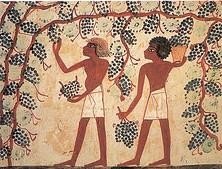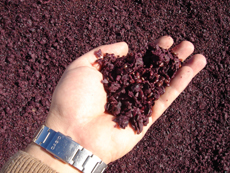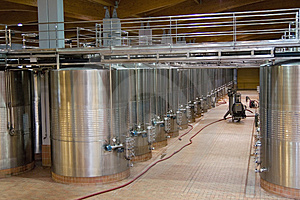Wine Production (Part I)

The history of wine production can be traced so long back that production techniques have varied immensely from the beginnings to the current methods. The first evidence of wine production is from the Egyptians, who favored beer but also produced wine for religious ceremonies. The whole process was manual, and from their techniques to the current days' a lot has changed. Wine production is a long process and requires hard work, especially if the quality has to be at least acceptable.
If you're ever travelling to Spain, you can't miss the opportunity of practicing wine tourism around the area, you'll be sure to learn this process first-hand from some of the best wine makers in Spain.
Destemming and crushing/pressing
The grapes are the first step of wine production. For the wine to be good, the grapes also have to be of good quality. The harvest normally takes place during September or October, after the heat of summer has ripened the grapes. After the harvest comes the destemming, which consists in taking the stems off the grapes. This can de done manually or mechanically. The huge volume of grapes harvested by most of the vineyards, especially those who produce a lot of wine, makes manual destemming impossible, but this method is still used in smaller wineries. Destemming is not compulsory; white wines are often fermented with the stems and leaves, but these are always removed in red wines because they contain tannins and they leave a vegetable taste on the wine.

After the destemming (in some cases these steps are done simultaneously) comes the crushing/pressing. This part of wine production consists in extracting the juice from the berries by squeezing them gently until they release their juices. In red wines, the berries are crushed and the skins are left with the must (the initial grape juice) so they absorb the tannins for their rich deep red color. The skins are taken out after fermentation. In the case of white wines, the grapes are squeezes, not crushed, to limit the absorption of tannins which would color the wine. With rosé wine, the process is a mix of both: the skins are left in long enough for the must to gain the color the wine maker wants, and then they're removed. The rest of the process is the same as for white wines.
Fermentation
Once the must is extracted, it's time for the fermentation. This part of composes most of the process of wine production, and it's the most important part. In fact, without fermentation wine would only be grape juice! The main purpose of fermentation is to turn the must sugars into ethyl alcohol, and this takes place thanks to the yeasts.
Fermentation is done in huge tanks, now made of stainless steel, and it takes place in four steps:

- Lag phase: the yeasts become acclimatized to the conditions of the must, high sugar concentration, low pH, temperature and sulfur dioxide. This normally takes around 2 or three days.
- Exponential growth: the yeasts are already acclimatized to their surroundings and start multiplying in an exponential growth until they reach their maximum density of population, around 100 million yeasts per centimeter squared. The yeasts consume the high sugar levels and the sugar concentration starts to descend quickly. This phase normally lasts around 4 days.
- Stationary phase: The yeast has reached its maximum capacity, which makes it stay stationary and fermentation continues at a steady pace. The heat released by the fermentation keeps the wine at a stable temperature.
- Declining phase: During this phase the lack of sugar and high alcohol concentration starts killing the yeasts, and the pace of the fermentation slows.
Fermentation is affected by several factors like temperature. It can only take place between 5ºC and 38ºC. The fermentation of white wines takes place at a lower temperature, between 8ºC and 14ºC; and red wines ferment between 25ºC and 30ºC. The fresh and aromatic flavors are best achieved with lower temperatures. Other things that affect fermentation are the levels of sugar, the acidity levels, the presence of micro nutrients like vitamins and even the airing of the barrel.
The malolactic fermentation takes place at the same time as the regular fermentation. During the malolactic fermentation, the tart-tasting malic acid naturally present in grape must is converted to softer-tasting lactic acid. Malolactic fermentation tends to create a rounder, fuller mouthfeel in the wines.
After the fermentation, which in total takes around 30 days, the bigger, solid particles still in the wine (in the case of the red wine, in which the skins of the berries are left during fermentation to let the wine develop it's color) are taken out and pressed to extract all the liquid. This is called "pressed wine" and must never be mixed with the other wines.
Continue reading about wine production
Spanish Wine History
Spanish Wine Regions and DO
Spanish Wine Tours
Top Spanish designations of origin
Best Spanish Wines
Spanish Wine Production
Spanish Wine Types
Spanish Grapes
Spanish Sparkling Wine: Cava
Sherry Wine
Spanish Wine Cocktails
Spanish Wines in the World
Spanish Wine Prizes
Enotourism
Spanish spirits and liquors
Argentina Wines
Chilean Wines
Other sites